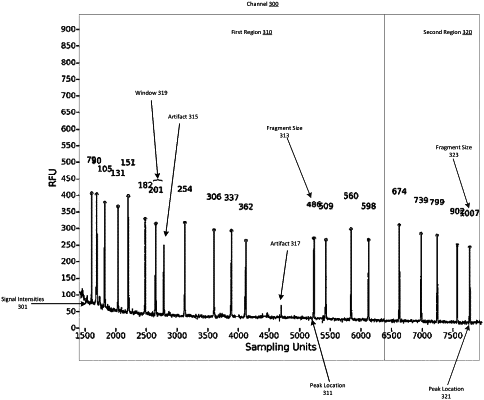| CPC C12Q 1/6858 (2013.01) | 10 Claims |

|
1. A method of sizing a repeat region of a nucleic acid, comprising:
i. providing a nucleic acid sample;
ii. amplifying a nucleic acid comprising a repeat region from the sample;
iii. performing capillary electrophoresis to obtain a ladder of amplification products;
iv. generating an internal sizing standard using the ladder of amplification products by:
identifying a repeat profile in a channel of the ladder of amplification products;
iteratively generating a set of repeat peak locations, the iterative generation comprising:
determining a predicted peak location in the repeat profile using a previous peak location and an interval value,
identifying a peak location within a window including the predicted peak location, and
adding the identified peak location to the set of repeat peak locations when a signal intensity at the identified peak location satisfies an amplitude criterion; and
estimating a linear relationship between repeat peak location and repeat fragment size using the set of repeat peak locations and a set of corresponding fragment sizes; and
v. sizing the repeat region using the internal sizing standard,
wherein sizing the repeat region further comprises using an external sizing standard,
wherein the external sizing standard is generated by:
identifying peaks in a channel of the ladder of amplification products, the peaks exceeding a local noise threshold;
iteratively re-estimating, using identified peaks in a first region of the channel, a linear relationship between peak location and fragment size using a first set of fragment sizes and a first set of corresponding peak locations, the iterative re-estimation comprising:
including progressively smaller fragment sizes into the first set of fragment sizes, and
including peak locations corresponding to the progressively smaller fragment sizes into the first set of corresponding peak locations;
estimating, using identified peaks in a second region of the channel, a non-linear relationship between peak location and fragment size for a second region of the channel using a second set of fragment sizes and a second set of corresponding peak locations; and
combining the linear relationship and the nonlinear relationship, thereby generating the external sizing standard.
|